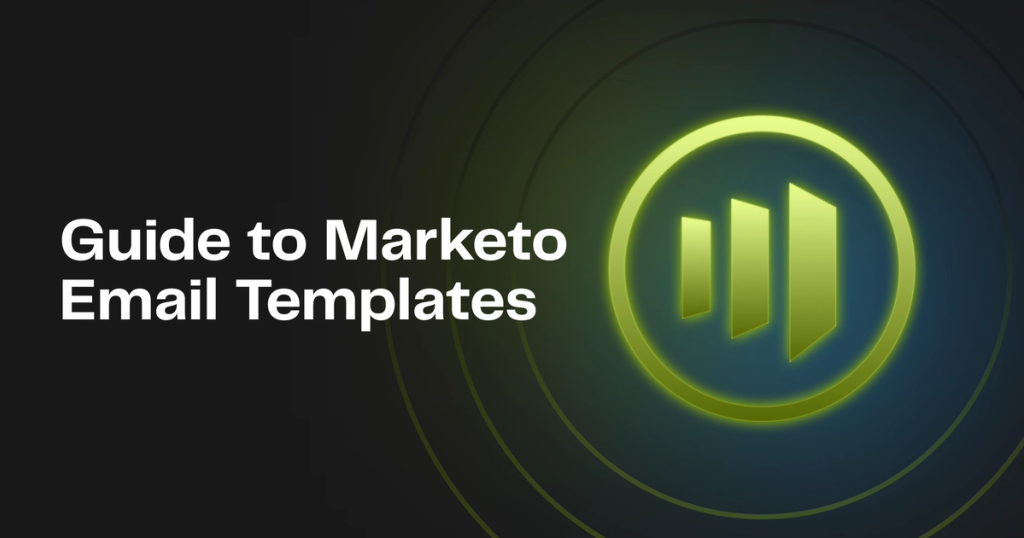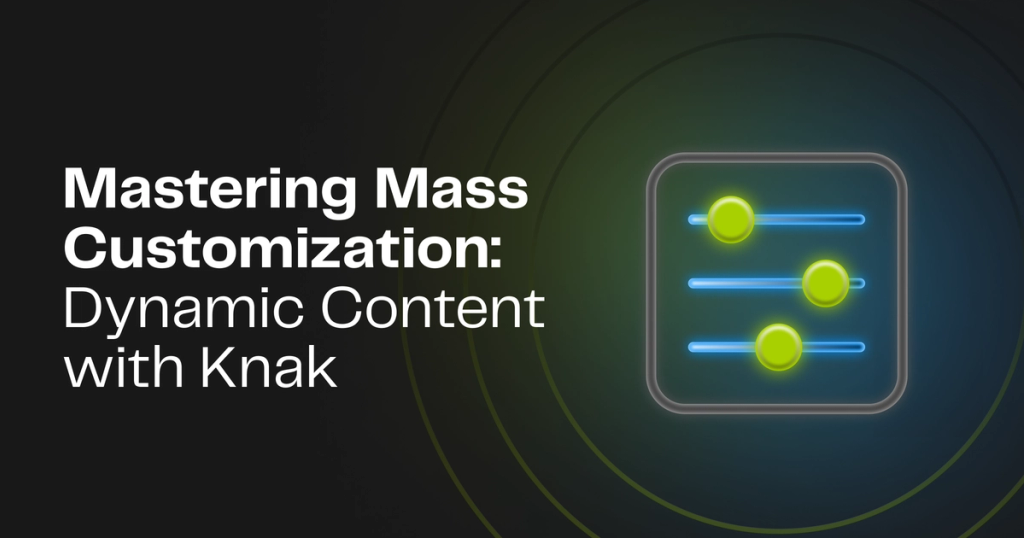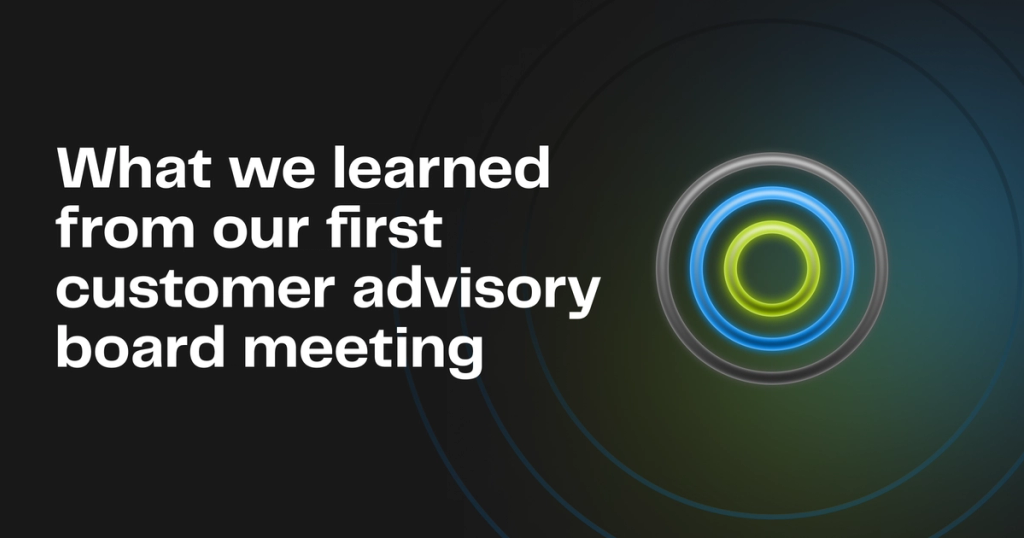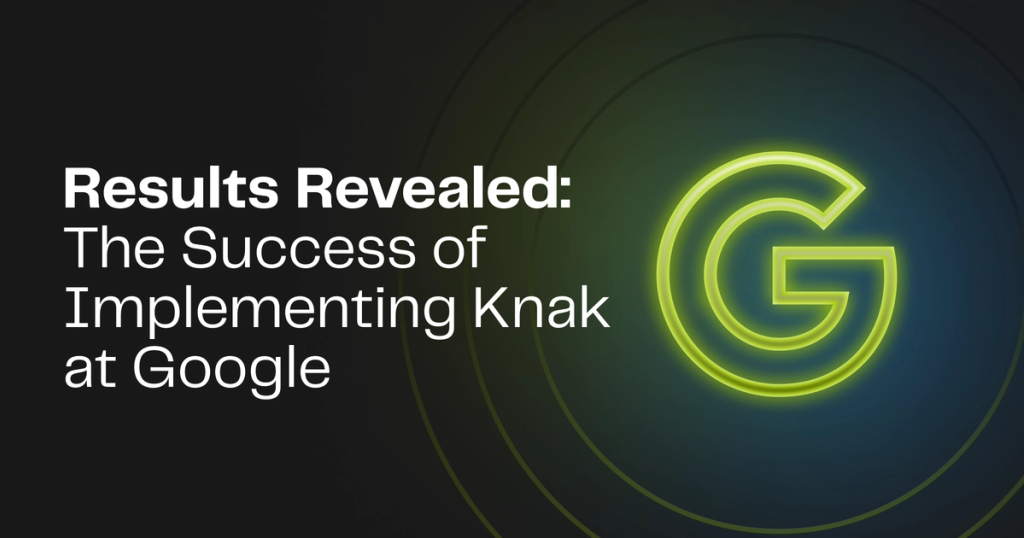Webinars are one of the most engaging and effective demand generation strategies in the digital marketing toolkit. They can drive engagement with your products, inform your audience of important trends, and even teach new skills. Perhaps the most important byproduct of webinars is that they can create a connection with potential customers, leaving a positive impression of your brand at the same time.
But, you have to get them to come to your webinar first.
Enter the unsung heroes of the webinar: the email sequence a.k.a the webinar campaign. This is what drives attendance and engages your prospects afterwards. It needs to tell your audience what your webinar is about in an enticing way, provide all the important details for attending, keep them excited as the event nears, ensure they actually show up, and then follow-up in a way that they’ll look forward to. That’s a fair bit of responsibility for a few emails. So it’s worth it to spend some time here to make sure every email ticks every box. But what are the best practices? And how do you implement them in your email sequences? We’ve got plenty of design inspiration for you in our Email Gallery. But, in this post, we’re going to focus on the types of webinar emails you should be building to support your webinar campaigns.
6 Types of Webinar Emails
Webinar emails can be broken out into 6 types:
- Invitation Email
- Registration Confirmation Email
- Reminder Emails
- Starting Now Email
- Follow Up Email
- Feedback
Let’s break these out to see where they’re used in a webinar campaign. We’ll start with a table that outlines the different emails, then dive a bit deeper into each type. And we’re going to use one of our webinar sequences as a visual example.
Types of Webinar Emails
Definition | Goal | Best Practices | |
|---|---|---|---|
Invitation Email | Invite email sent to a segmented list of people you’ve identified as a good fit for the event. | Registrations | Single CTA, provide key event details, keep it compelling but concise. |
Registration Confirmation | Email to confirm registration and reinforce branding; validate registrants’ decisions to attend the webinar. | Confirm Attendance | Include branding and an add-to-calendar link. |
Didn’t Open/Click Reminders | Email to remind those who did not register that this is their last chance to do so. | Increase Registrations | Reinforce the key takeaway of the webinar, add some FOMO language. |
Reminder Email – Day Before | Emails to remind registrants of key dates and information | Attendance Conversion | Include date, time, webinar link, and an add-to-calendar link; use plain text and simple design. |
Last-Minute/Starting Now | Email sent right before the webinar starts to provide a join link | On-Time Attendance | Ensure attendees have the join link; solid integration with the webinar provider. |
Follow-up/Thank You | Email to send recording to attendees and registrants, and to get direct feedback | Feedback, Engagement | Send VOD of recording, get feedback, consider using a personalized email sender like presenter or sales. |
Feedback or Survey | Email to gather feedback or conduct a survey; may be optional depending on the number of emails sent and the type of event | Insights, Response Rate | Consider something interactive and simple, evaluate based on the type and number of emails sent. |
Invitation Email | |
Definition | Invite email sent to a segmented list of people you’ve identified as a good fit for the event. |
Goal | Registrations |
Best Practices | Single CTA, provide key event details, keep it compelling but concise. |
Registration Confirmation | |
Definition | Email to confirm registration and reinforce branding; validate registrants’ decisions to attend the webinar. |
Goal | Confirm Attendance |
Best Practices | Include branding and an add-to-calendar link. |
Didn’t Open/Click Reminders | |
Definition | Email to remind those who did not register that this is their last chance to do so. |
Goal | Increase Registrations |
Best Practices | Reinforce the key takeaway of the webinar, add some FOMO language. |
Reminder Email – Day Before | |
Definition | Emails to remind registrants of key dates and information |
Goal | Attendance Conversion |
Best Practices | Include date, time, webinar link, and an add-to-calendar link; use plain text and simple design. |
Last-Minute/Starting Now | |
Definition | Email sent right before the webinar starts to provide a join link |
Goal | On-Time Attendance |
Best Practices | Ensure attendees have the join link; solid integration with the webinar provider. |
Follow-up/Thank You | |
Definition | Email to send recording to attendees and registrants, and to get direct feedback |
Goal | Feedback, Engagement |
Best Practices | Send VOD of recording, get feedback, consider using a personalized email sender like presenter or sales. |
Feedback or Survey | |
Definition | Email to gather feedback or conduct a survey; may be optional depending on the number of emails sent and the type of event |
Goal | Insights, Response Rate |
Best Practices | Consider something interactive and simple, evaluate based on the type and number of emails sent. |
Invitation Email
The webinar invitation is the email you want to focus on the most. This is because your goal with this email is to drive the initial registrations for your webinar (which will be the bulk of them).
Best practices for the invitation email are to create an enticing hook to take action. For example, tell them what they can expect to learn or take away from the event. Ensure your call to action is prominently displayed. And make sure the email is concise. Don’t forget to include key webinar event details, such as date, time, and registration instructions. A subtle point that is often overlooked is having a consistent experience from email to registration form. Sending users directly to a webinar platform to register isn’t ideal; consider the landing page experience, and make sure you’re providing a cohesive journey from email to form fill.
Below is an invitation email we created for a recent webinar.

Registration Confirmation Email
The most common mistake with Registration Confirmation email is leaving them in the webinar provider’s default state. Most will send automated emails to confirm registration, and, unsurprisingly, these emails are rarely a good representation of your brand.
In Marketo, for example, you can directly set up an integration with webinar providers to customize the emails that get sent – not just the design, but also when the emails are sent. Open rates on registration confirmation emails as a rule are quite high – most users expect to get this email. So why not use this opportunity to reinforce your brand?
Protip: While there isn’t a solid goal for this email (other than delivering a good experience), we strongly recommend including an add-to-calendar link or module in the confirmation. This is going to make it infinitely easier for them to remember the webinar date and time — and that’s going to improve overall attendance.
Below is an example of what a confirmation email looks like.

No Open/No Click Reminder Email
Just because they didn’t open it or register for the webinar when you sent the initial registration email doesn’t mean they don’t want to come. They may have missed it, didn’t have the time to read the email, or just need a gentle reminder. Either way, it doesn’t hurt to send a quick reminder to folks that didn’t register the first time. Be sure to use a different subject line. Be brief about what the webinar is about. And try to use some FOMO in your copy; for example: “Last chance to save your spot”.
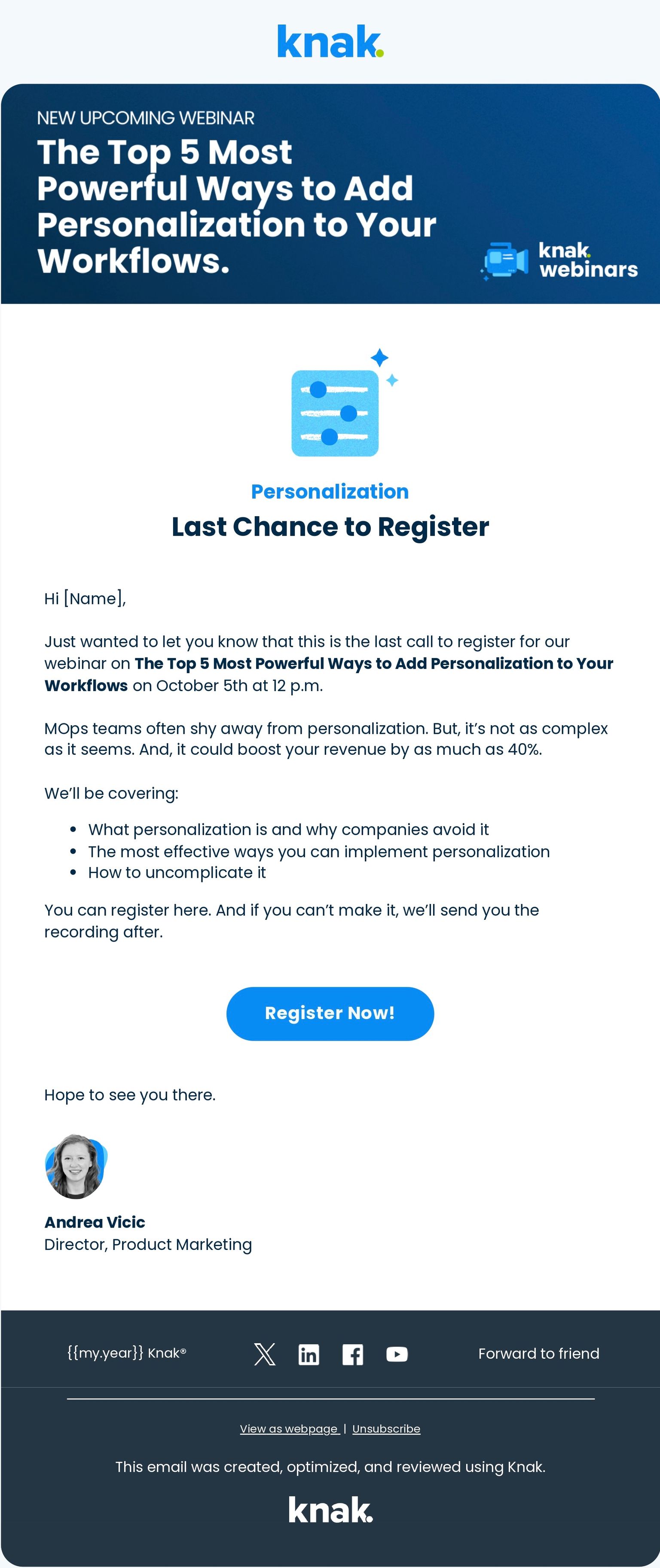
A little bit of FOMO can go a long way!
Day Before Reminder Email
Demand generation vets know the universal truth of webinars: it’s really tough to get people to show up — even if they’ve registered. Some sources say that you can expect between 20-30% of initial registrations, and this jives well with what I’ve seen in my career.
These rates should (and could) be much higher! Too often the reminder emails are left in the hands of the webinar provider. So users end up getting generic, automated emails with the bare minimum of details. If we’re serious about improving the attendance rate of our webinars, then we should take full advantage of our email marketing capabilities.
Reminder emails should aim to reignite the spark that prompted the prospect to register for the webinar in the first place. What will they get out of attending? Reinforce that effectively, and you’ll see your webinars beat industry benchmarks.
Last-Minute or “Starting Now” Email
It’s gameday, and you want to maximize attendance with a “starting now” email. This email may be the most impactful email you send throughout your webinar email sequence. You do not want registrants scrambling to find the “Join Webinar” link at the 11th hour.
It’s important that this email includes key details like the webinar link. In tools like Marketo, you can directly integrate with the webinar provider to fetch and use the webinar link, even if it’s personalized.
As you might have noticed, I’m not a fan of having webinar providers send automated emails. Sure, they are a good way to foolproof your campaign if you’re short on resources. But why outsource your branding to another platform? Your webinar sequence represents a great opportunity to connect with your audience and, critically, make sure they have all the event details right.
Below is an example of a day-of email letting you know the webinar is about to go down.

Follow-up or Thank You Email
If the live webinar event was a meal at a restaurant, it’d be the main course. The lead up to the event – all the emails and digital marketing – are the appetizer. So, the follow-up email is like dessert; a fitting way to cap off a great experience. And, just like dessert, it can leave a lasting impression that carries well beyond the current meal.
When it comes to your webinar email sequence, take extra care with your follow-up/thank you emails. The value you provided during the webinar experience should carry through to your follow up. The event follow-up email is the most often overlooked, and that’s unfortunate because it’s a great opportunity to finish the experience on a high note.
As a best practice, send all registrants a video-on-demand link to the webinar – life happens, and sometimes would-be attendees can’t make the live event. Many registrants will sign up simply to get the VOD, and there’s nothing wrong with that.

Don’t forget to say thanks!
Feedback or Survey Email
While you could argue that sending a feedback or survey email after every webinar isn’t necessary, it certainly isn’t a bad idea to incorporate this into your campaign playbook. Perhaps you only send feedback emails to users after they’ve attended their first webinar with you, or time it and send every other webinar.
The feedback email demonstrates that you are actively listening to your audience and keen to continue delivering value. You can keep it simple with a rating system so it only takes a single click to give feedback, or you could invite direct feedback via a reply-to.

Getting feedback means better future webinars!
A Note on Timing
How long before the event do you send the first invite? How about the reminder to those who didn’t open? And how soon do you follow-up afterwards? Let’s break that down:
Email Type | Timing |
|---|---|
Initial Invite | 2 – 4 weeks prior |
Confirmation | Within an hour of registration |
No Open/Click Reminder | 1 – 2 weeks prior |
First Reminder | 1 week prior |
Gameday Reminder | Within an hour prior to the event |
Thank You Email | Within a 3 days after the event (as soon as the video recording is ready) |
Survey/Feedback | Within a week after the event |
Email Type | Initial Invite |
Timing | 2 – 4 weeks prior |
Email Type | Confirmation |
Timing | Within an hour of registration |
Email Type | No Open/Click Reminder |
Timing | 1 – 2 weeks prior |
Email Type | First Reminder |
Timing | 1 week prior |
Email Type | Gameday Reminder |
Timing | Within an hour prior to the event |
Email Type | Thank You Email |
Timing | Within a 3 days after the event (as soon as the video recording is ready) |
Email Type | Survey/Feedback |
Timing | Within a week after the event |
How Knak Makes Your Webinar Campaign Even Easier
While this post aims to make your email sequence straightforward, we know that building campaigns within enterprise-grade marketing automation platforms (MAP) is anything but. Knak takes the building part out of your MAP and into a no-code platform that makes it easy, lets you to set up brand guardrails, and allows for simple personalization and localization. Then you use your MAP to plan and send your campaign. That means getting your emails to market up to 95% faster. Visit us to learn more.
Types of Webinar Emails FAQ
How many types of webinars are there?
There are 9 types of webinars:
- Educational webinars
- Product demo webinar
- Workshops or training webinars
- Panel discussions
- Q&A or AMA webinars
- Thought leadership webinars
- Sales webinar
- Hybrid webinars mixing in-persona and virtual components
- Webinar series
What should a webinar confirmation email say?
Your webinar confirmation email should thank users for registering for your event, provide or reiterate key details about the event's date and time, and information about how to attend the event. You can also take this opportunity to set expectations about future reminder emails, and reinforce what the webinar is about.
How do I follow-up on a webinar?
Your webinar follow-up email should thank the person for attending, give them access to any follow-up resources (such as PDFs, etc), and invite feedback about the webinar. You may also include a call-to-action like offering a free trial to your product or a personalized sales demo.
What type of program should I use for webinars in Marketo?
Use the "Event Program" in Marketo to run your webinar campaigns. This program type is designed for webinars and has features to allow you to directly integrate with a webinar provider to track and register your webinar registrations.




